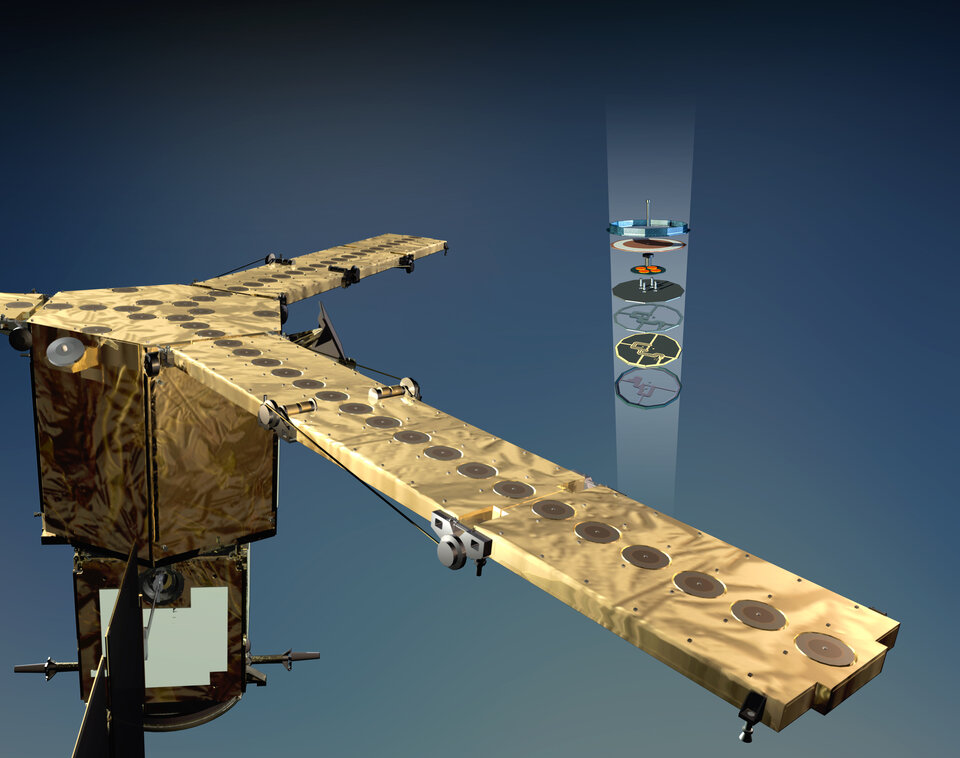SMOS payload in the sunshine
Yet another milestone for the SMOS (Soil Moisture and Ocean Salinity) mission has been passed – the 'Thermal Balance Test' for the Structural Thermal Model of the payload has successfully been completed in the Large Space Simulator at ESA-ESTEC's test facilities in Noordwijk, the Netherlands.
SMOS will carry an innovative radiometer that operates at 1.4 GHz (L-band) called MIRAS (Microwave Imaging Radiometer using Aperture Synthesis). In order to predict how MIRAS will perform once launched, the differences in temperatures that all the important parts of the satellite will experience have to be known. Therefore, a 'thermal mathematical model' was set up to calculate the internal temperature distribution. This model has to take account of the external heat exchange from the Sun, the Earth's albedo, and heat losses to space, as well as all the internal conductive and radiative fluxes.
Radiation from the Sun changes over the year and the satellite will have different orientations during launch and when it is operational - all these different conditions need to be simulated and carefully analysed. The means of thermal control, which involve radiators to radiate away the heat generated by the electronics, thermal blankets to isolate components from a changing environment and heaters to prevent temperatures falling too low, will be designed based on the results of these tests.
Although this modelling technique is well established in the space business, there is still the need to make sure that the predictions are correct. To this end, the thermal balance test simulates the space environment as accurately as possible and measures the resulting temperature distribution. Comparisons are then made with the model's prediction.

However, even Europe's biggest test facility, the Large Space Simulator at ESA-ESTEC, which has a diameter of 10 metres and simulates a 6-metre wide sunbeam, is barely able to accommodate the fully deployed SMOS payload – a central structure with three deployable 4-metre long arms. Fortunately, full deployment is not really necessary since the mathematical model, when suitably adapted to the test situation, allows a reduced configuration to provide the answers.
This is what was done for SMOS. Following the completion of the mechanical tests (involving vibration, acoustic and deployment trials), two of the stacks of folded arm segments were removed, and the remaining one fully deployed. Some 200 temperature sensors were installed to gain a detailed picture of the internal temperature distribution. In order to be able to change the orientation of the payload with respect to the simulated sunbeam sophisticated mechanical ground support equipment was mounted; thus seasonal variation of illumination conditions could be simulated.

Of course, such complicated testing requires the full cooperation of many people - the payload developer and operators, the people running the facility, and those acquiring and interpreting the results. Achim Hahne, Project Manager for SMOS commented, "This was a hard and intense period of work, but thanks to good preparation and excellent team spirit between the various partners, everything went extremely smoothly."
After the intense weeks of preparation and now the completion of the tests, the message happily reads, 'Mission Accomplished!'















 Germany
Germany
 Austria
Austria
 Belgium
Belgium
 Denmark
Denmark
 Spain
Spain
 Estonia
Estonia
 Finland
Finland
 France
France
 Greece
Greece
 Hungary
Hungary
 Ireland
Ireland
 Italy
Italy
 Luxembourg
Luxembourg
 Norway
Norway
 The Netherlands
The Netherlands
 Poland
Poland
 Portugal
Portugal
 Czechia
Czechia
 Romania
Romania
 United Kingdom
United Kingdom
 Slovenia
Slovenia
 Sweden
Sweden
 Switzerland
Switzerland





























